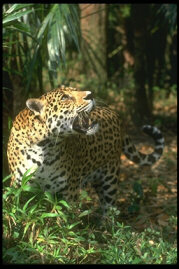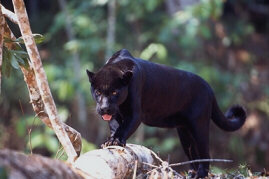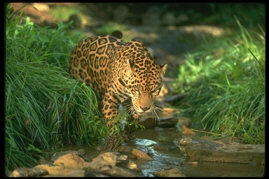Animals
Sub-Menu
|
Jaguar
 The name jaguar comes
from the Indian word yaguar, meaning "he
who kills with one leap". The jaguar is also the
only one of the big cats which doesn't roar. The name jaguar comes
from the Indian word yaguar, meaning "he
who kills with one leap". The jaguar is also the
only one of the big cats which doesn't roar.
The jaguar is the most magestic and certainly one of
the most beautiful animals in the Amazon rainforest. It
is the largest cat in the Americas (and third largest in
the world after the lion and tiger) weighing up to 160
kg. However, jaguars in the Amazon rainforests tend to be
smaller than average, probably due to the smaller size of
their prey compared to more open areas. Forest-living
jaguars tend also to have a darker colouring which
enables them to hide better in the dark forest
undergrowth. Melanistic jaguars, coloured entirely black,
are also occasionally found in forested areas.
 Despite its heavy build, the jaguar is very
agile and can run fast over short distances. It climbs
trees, where it sometimes sits while waiting for its
prey, and is a good swimmer. When hunting it is extremely
fierce, occasionally diving into the waters of rivers and
streams to attack jacarés. They
have very powerful jaws which enable them to bite through
the protective shells of armadillos, or to crush through
an animal's skull with a single bite. Other things that
jaguars eat include wild pigs (peccaries), capybara, fish, lizards, deer,
and sloths. The jaguar's only
natural enemy, other than man, is the anaconda – a giant snake
which hides in rivers and streams, sometimes attacking
and suffocating jaguars and they attempt to cross. Despite its heavy build, the jaguar is very
agile and can run fast over short distances. It climbs
trees, where it sometimes sits while waiting for its
prey, and is a good swimmer. When hunting it is extremely
fierce, occasionally diving into the waters of rivers and
streams to attack jacarés. They
have very powerful jaws which enable them to bite through
the protective shells of armadillos, or to crush through
an animal's skull with a single bite. Other things that
jaguars eat include wild pigs (peccaries), capybara, fish, lizards, deer,
and sloths. The jaguar's only
natural enemy, other than man, is the anaconda – a giant snake
which hides in rivers and streams, sometimes attacking
and suffocating jaguars and they attempt to cross.
 Jaguars
also have the reputation for being mankillers, but this
may only be when they are threatened or short of food
– there are numerous stories of travellers in
rainforests being followed by a solitary jaguar which,
instead of stalking them as prey, appears merely to be
escorting them off its territory. There are even stories
from Amazon Indians of jaguars emerging from the
rainforest to play with village children. Jaguars
also have the reputation for being mankillers, but this
may only be when they are threatened or short of food
– there are numerous stories of travellers in
rainforests being followed by a solitary jaguar which,
instead of stalking them as prey, appears merely to be
escorting them off its territory. There are even stories
from Amazon Indians of jaguars emerging from the
rainforest to play with village children.
The jaguar's original habitat stretched from the
south-western United States, down through Central and
South America to the bottom of Argentina. However, their
numbers have declined dramatically. They are now
virtually extinct in the United States, and continued
deforestation is fragmenting the population into isolated
pockets in which it is difficult to sustain numbers.
Jaguars have been known to survive in a circular area
three miles across but, where food is scarce, a single
jaguar may need to roam an area as great as 200 square
miles. In the Central American country of Belize, the
government has set aside 150 square miles of rainforest
as a reserve which is home to about 200 jaguars –
the greatest concentration of jaguars in the world. It is
estimated that there are about 15,000 jaguars remaining.
 Another
significant factor in the jaguar's decline has been
hunting – it is estimated that during the peak of
hunting in the 1960s and 70s, about 18,000 jaguars (and
80,000 ocelots) were being
slaughtered each year for their valuable skins.
Commercial hunting is now outlawed, and it is illegal to
buy or sell jaguar skins or related products, but illegal
hunting still continues on a smaller scale and it is
still possible to buy jaguar skins in some markets.
Hunters generally hunt for jaguars at night – one
hunter stands on the shore near a river or stream playing
an instrument which imitates the panting groan of other
jaguars. If a jaguar comes to investigate the noise, it
is spotlighted by the hunter's companion (sitting in a
boat near the shore), and then shot using a high powered
rifle. Another
significant factor in the jaguar's decline has been
hunting – it is estimated that during the peak of
hunting in the 1960s and 70s, about 18,000 jaguars (and
80,000 ocelots) were being
slaughtered each year for their valuable skins.
Commercial hunting is now outlawed, and it is illegal to
buy or sell jaguar skins or related products, but illegal
hunting still continues on a smaller scale and it is
still possible to buy jaguar skins in some markets.
Hunters generally hunt for jaguars at night – one
hunter stands on the shore near a river or stream playing
an instrument which imitates the panting groan of other
jaguars. If a jaguar comes to investigate the noise, it
is spotlighted by the hunter's companion (sitting in a
boat near the shore), and then shot using a high powered
rifle.
The power and fine hunting skills of the jaguar was
well respected by the Indians. Many Amazon tribes claim
to have been decended from jaguars, and jaguar gods were
worshipped by ancient Indian civilisations including the
Aztecs and the Chavin (predecessors of the Inca).
|